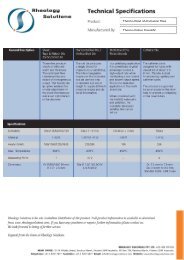Download - Rheology Solutions
Download - Rheology Solutions
Download - Rheology Solutions
You also want an ePaper? Increase the reach of your titles
YUMPU automatically turns print PDFs into web optimized ePapers that Google loves.
application notes & technical articles<br />
<strong>Rheology</strong> as a Tool for Immiscible<br />
Polymer Blends Characterisation:<br />
Interfacial Tension and<br />
Compatibilisation<br />
Polymer blends have gained an increasing<br />
popularity in the field of polymer science and<br />
industry during the last thirty years. The growth in<br />
the use of polymer blends is mainly due to their<br />
ability to combine the properties of their phases<br />
in a unique product, making polymer blends<br />
broadly employed in automobile, aerospace,<br />
packing, and general goods industries. Currently,<br />
about 40% of the world polymer market is<br />
involved with the production of polymer blends,<br />
representing trades of billions of US$ a year. The<br />
final properties of polymer blends are directly<br />
related to the quality of their morphology, which in<br />
turn depends on the rheological properties of the<br />
phases of the blend, on the composition of the<br />
blend, on the processing conditions of the blend,<br />
and on the interfacial tension between the<br />
polymers forming the blend. However, most<br />
polymer blends are incompatible, resulting in<br />
materials with coarse morphology, weak adhesion<br />
among phases and poor mechanical properties. In<br />
fact, the future of polymer blends is based on<br />
biennial 07-08<br />
polymer industries<br />
methods to achieve stable morphologies, so that<br />
the enhanced and optimized properties of<br />
polymer blends do not change during the product<br />
processing due to phenomena such as<br />
coalescence and breakup. This matter still<br />
remains an industrial challenge and is the object<br />
of intense research.<br />
Interfacial tension between molten polymers has<br />
received considerable experimental and<br />
theoretical attention due to its implication in<br />
several industrial applications such as coating,<br />
composites and especially in polymer blends.<br />
Interfacial tension is the single most accessible<br />
parameter that describes the thermodynamic<br />
state and structure of an interface in polymer<br />
blends, therefore directly related to compatibility<br />
and hence morphology of polymer blends. Also,<br />
interfacial tension can be considered as a key<br />
parameter that measures the state of miscibility<br />
between incompatible polymers. The compatibility<br />
between the phases of a blend can be improved<br />
by the addition of compatibilisers which result in<br />
a finer and more stable morphology, better<br />
adhesion between the phases of the blends and<br />
consequently better properties of the final<br />
product. The exact definition of the optimum<br />
concentration of compatibiliser to be added is<br />
associated with the costs minimisation, since<br />
most compatibilisers are much more expensive<br />
than ordinary polymers.<br />
In this work, rheological measurements are<br />
shown to be a useful technique to study polymer<br />
blends. In particular, they can be used to<br />
determine the interfacial tension between<br />
immiscible polymers and define the optimum<br />
concentration of compatibiliser to be added to the<br />
blend. This study is based on the execution of<br />
small amplitude oscillatory shear (SAOS) tests in<br />
the linear viscoelasticity region of the materials.<br />
The determination of interfacial tension is related<br />
to the study of relaxation spectrum of a polymer<br />
blend, which is a result of the contribution of the<br />
phases and the interface. The definition of the<br />
concentration of compatibiliser is determined<br />
studying the applicability of time-temperature<br />
superposition (TTS) for the blend as a function of<br />
compatibiliser concentration.<br />
A full copy of the paper is available by<br />
quoting reference no. RF- 110902-br-01<br />
application notes & technical articles<br />
Rheological and Microstructural<br />
Analysis of a Model Rennet Casein<br />
Gel as Influenced by Cooling Rate<br />
food industries<br />
Cooling is a final process during process cheese<br />
production and is therefore critical when<br />
determining the texture and functional properties<br />
of the product. It is well established that a slower<br />
cooling yields a firmer cheese. However, there is a<br />
lack of quantitative description of this operation,<br />
and the mechanism behind the observation is<br />
needed to better control the cooling process. The<br />
rheological data for process cheese cooled at<br />
different rates was quantified and was consistent<br />
with the industrial observation. To illustrate<br />
physical changes during cooling, rennet casein<br />
gels were studied as our first step in<br />
understanding the cooling effects on process<br />
cheese texture and microstructure. A similar trend<br />
in storage modulus to process cheese was<br />
observed when the casein gels were cooled at<br />
different rates. To explain this behavior, a<br />
schematic illustration was used as the physical<br />
bases for microstructure of colloidal gels that can<br />
result in different rheological properties. Fractal<br />
dimension, floc size, and floc order in the protein<br />
network were treated as three possible variables.<br />
The theory developed by Shih et al. (1990) was<br />
used to determine the floc fractal dimension, and<br />
a confocal laser scanning microscope observed<br />
the floc size and order. The results showed that<br />
the floc fractal dimension and size were not<br />
significantly different when casein gels were<br />
cooled at different rates. However, the cooling did<br />
impact floc arrangement in the protein network. A<br />
higher order at a slower cooling rate resulted in a<br />
higher storage modulus, a smaller limit of linear<br />
viscoelastic range, and an increase in gelation<br />
temperature. The rheological data were consistent<br />
with the microscopic images, and the<br />
hypothesised variables sufficiently explained the<br />
physical changes in casein gels during cooling at<br />
different rates.<br />
A full copy of the paper is available by<br />
quoting reference no. RF- 200902-US-01<br />
12 www.rheologysolutions.com










